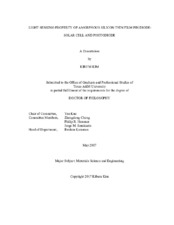Light Sensing Property of Amorphous Silicon Thin Film pin Diode: Solar Cell and Photodiode
Abstract
The performance and stress-induced degradation of a-Si:H solar cells with pin and nip stacked structures prepared in the single chamber PECVD have been studied. The property of the i-layer depends on the sequence of film deposition because the intrinsic (i)-layer is contaminated by the dopant residue in the chamber remaining from the previous deposition step. This affects the solar cell performance, degradation, as well as recovery. Also, the cell degradation under the electric-stress condition with and without the simultaneous light exposure has been studied.
The light sensing characteristics of the a-Si:H pin diode composed of both top and bottom ITO electrodes with respect to the power density of red (625nm), green (530nm), and blue (470nm) illumination lights have been studied. The study’s findings indicate that the light detection of the diode is affected by both the wavelength and power density of the incident light. Such influence turns out to be due to the dependence of the asymmetric carrier loss on the light wavelength and power density. Also, changes in pin diode characteristics have been confirmed by internal resistances, short circuit current density, and open circuit voltage, as well as the application of a bottom light reflector.
The mechanism of asymmetric carrier transfers in the light-sensing of the a-Si:H pin diode has been discussed using different i-layer thickness, combined electric-optical stress method, and three narrow-band lights. The position of the photo-generated electron-hole pairs within the i-layer varies with the wavelength of the incident light, which directly affects the asymmetric transfer and loss of the carriers. This has been confirmed with the i-layer thickness and combined electric-optical stress method.
Citation
Kim, Kibum (2017). Light Sensing Property of Amorphous Silicon Thin Film pin Diode: Solar Cell and Photodiode. Doctoral dissertation, Texas A & M University. Available electronically from https : / /hdl .handle .net /1969 .1 /161387.


